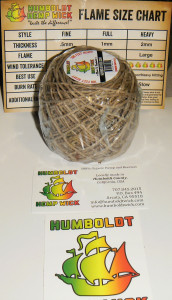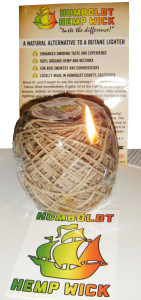Posts Tagged ‘hemp’
Humboldt Traders Hemp Wick
 I got my free sample of Hemp Wick from Humboldt Traders in the mail today and while I was expecting a small sample I instead got a 100 foot roll of heavy wick.
I got my free sample of Hemp Wick from Humboldt Traders in the mail today and while I was expecting a small sample I instead got a 100 foot roll of heavy wick.
OK, so it’s hemp used to light cannabis, big deal, I have a butane lighter that does a fine job every time i use it, which is dozens of times a day, why should I use a Hemp wick to spark my bowl?
Let’s do a little research on butane, shall we?
A quick Google of “Butane inhalation” brought me to this…
Neurotoxic Effects from Butane Gas
Acute Intoxication
Because butane gas inhalants enter through the pulmonary system, they immediately enter into the blood supply and within seconds produce intoxication. The acute effects of inhalants include dizziness, hypertension (increased blood pressure), tachycardia (increased heart rate), impaired coordination, disorientation, temporal distortion, confusion, thick slurred speech, delirium, hallucinations, assaults and suicide attempts. Depending upon the inhalant, recovery may take minutes to hours or may not occur at all. Single episode use can be fatal because of oxygen displacement from red blood cells, hypoxia and asphyxiation. Victims of pulmonary effects are often found with a paper bag over the head.Profound relaxation and deep sleep usually follow the initial euphoric phase.Unpleasant symptoms reported after the use of inhalants include agitation, seizures, ataxia, headache, and dizziness.
https://www.thcfarmer.com/community/threads/neurotoxic-effects-from-butane-gas.15291/
Yea, I can see where I have been taking in a LOT of butane over the last 40 some years of chronic weed consumption, so I can see the upside to using Hemp Wick to cut back on the neurotoxic effects from clicking my Bic.
Also, Humboldt Traders has this on their website: https://humboldt-traders.com/butane-is-bad/
But what about the taste? does it really make it better? I can’t really say one way or the other but I did notice the ease with which I could “corner” my bowl with a more precise application of flame, properly done I can get 4 “green hits” off the same bowl, win…and I’m not trying to hold a lighter in a manner that mostly ensures it will singe my thumb…win, and when passing the bowl around the circle there isn’t the annoying “hot lighter” effect that can harsh a buzz.
 Overall I give this a very good rating, and I will certainly allocate a few feet of it to my camping supplies and survival “bug out bag”.
Overall I give this a very good rating, and I will certainly allocate a few feet of it to my camping supplies and survival “bug out bag”.
Stop by Humboldt Traders and grab your own free sample, hey, it’s free, and they even sent me a free sticker to go along with it. I’m suspecting once you try it most will find it adds to the smoking experience, kind of like the exquisiteness of a Japanese Tea ceremony adds to the flavor of the Tea.
Why You Will Soon Be Building Your Home With Hempcrete
 As state after state slowly moves towards marijuana legalization, it seems like everyone is trying to cash in on the pot-farming boom. But legalization opens the door to a world of innovation and entrepreneurship that’s a lot wider than new, inventive ways to get high, like weed sodas. In “green rush” states like Colorado, farmers are taking advantage of the new legal environment to sow fields of hemp, marijuana’s THC-deficient cousin. Because of its relationship to cannabis, hemp has been illegal in America for over 60 years, despite a consistent chorus of supporters who have touted its use as a natural fiber and food supplement in Canada and Europe. Compared to the economic potential of legalized marijuana, that of pot’s fibrous cousin seems like small potatoes. Yet one use of the plant could revolutionize construction in the U.S., creating a new, lucrative industry for growers: Hempcrete.
As state after state slowly moves towards marijuana legalization, it seems like everyone is trying to cash in on the pot-farming boom. But legalization opens the door to a world of innovation and entrepreneurship that’s a lot wider than new, inventive ways to get high, like weed sodas. In “green rush” states like Colorado, farmers are taking advantage of the new legal environment to sow fields of hemp, marijuana’s THC-deficient cousin. Because of its relationship to cannabis, hemp has been illegal in America for over 60 years, despite a consistent chorus of supporters who have touted its use as a natural fiber and food supplement in Canada and Europe. Compared to the economic potential of legalized marijuana, that of pot’s fibrous cousin seems like small potatoes. Yet one use of the plant could revolutionize construction in the U.S., creating a new, lucrative industry for growers: Hempcrete.
Read more at: http://magazine.good.is/articles/a-house-of-hemp
facebook – Hemp for Alaska
Alaska Hemp gives a tip of the hat to
Some of what they had to say recently…
http://thejointblog.com/hemp-is-effective-in-cleaning-nuclear-disasters/

Let’s Focus On Industrial Hemp
Norris McDonald and Roy Patrick, Contributors
Industrial hemp is a ‘legal weed’ with annual sales in the United States (US) averaging about US$500 million dollars. This is expected to rise because of the push to decriminalize all forms of marijuana (cannabis sativa) especially its non-toxic cousin, the hemp plant. Ganja is merely one of 500 varieties of this hemp plant and there is no reason Jamaica can’t begin a pilot study in industrial hemp production.
Industrial hemp is in the spotlight as many countries race to boost production. Governor Jerry Brown, of California, recently signed a law legalizing industrial hemp production. America is a large consumer of industrial hemp products but, at present, most of it is bought from overseas.
Canada is the biggest supplier of industrial hemp to America, and it may well be possible for Jamaica to become a big exporter to the US and other markets. The US (Hawaii), Canada, Great Britain, Russia, Germany, China, Japan, France are among the roughly 27 countries worldwide which grow industrial Hemp. Unlike ganja, it has lower levels of drug toxicity, hence its risk for being abused is considerably less.
http://jamaica-gleaner.com/gleaner/20131122/cleisure/cleisure4.html
Smoke Signals
Marijuana legalization: How Colorado is following Alaska’s smoke trail
When the final tally rang on election night, hundreds of thousands of voters in Colorado and Washington rejoiced at the passing of their respective marijuana bills. In these states, the people had spoken: legalize it. Amid the hazy celebrations, however, one acknowledgement was conspicuously absent. Alaska had actually legalized marijuana first. Sort of.
Read more…
http://blogs.westword.com/latestword/2013/02/marijuana_legalization_colorado_alaska.php
Feasibility of Industrial Hemp Production in the United States Pacific Northwest
For many centuries hemp (Cannabis sativa L.) has been cultivated as a source of strong stem fibers, seed oil, and psychoactive drugs in its leaves and flowers. Environmental concerns and recent shortages of wood fiber have renewed interest in hemp as a raw material for a wide range of industrial products including textiles, paper, and composite wood products. This report assesses the agricultural feasibility of industrial hemp production in the Pacific Northwest (PNW).
Hemp is an herbaceous annual that develops a rigid woody stem ranging in height from 1 to over 5 meters (3 to 19 feet). Hemp stalks have a woody core surrounded by a bark layer containing long fibers that extend nearly the entire length of the stem. Plant breeders have developed hemp varieties with increased stem fiber content and very low levels of delta-9-tetrahydro-cannabinol (THC), the psychoactive ingredient of marijuana.
Historically, hemp fiber was used mainly for cordage, but it can also be made into textiles, paper, and composite wood products. Demand for hemp cordage peaked in the late 1800’s, and world hemp production has continuously declined since that time, except for brief increases during both World Wars. Hemp fiber has largely been replaced by relatively inexpensive natural and synthetic fibers.
Although hemp is well adapted to the temperate climatic zone and will grow under varied environmental conditions, it grows best with warm growing conditions, an extended frost-free season, highly productive agricultural soils, and abundant moisture throughout the growing season. When grown under proper conditions, hemp is very competitive with weeds, and herbicides are generally not required in hemp production. Although a number of insect pests and diseases have been reported on hemp, significant crop losses from pests are not common. High levels of soil fertility are required to maximize hemp productivity. Cultural requirements and production costs are quite similar to those of corn. Reported hemp yields range from 2.5 to 8.7 tons of dry stems per acre.
The climatic and soil requirements of hemp can be met in some agricultural areas of the PNW, however, hemp will almost certainly require irrigation to reliably maximize productivity in the region. The requirement for supplemental irrigation will place hemp in direct competition with the highest value crops in the PNW, limiting available acreage. Stem yields will have to be substantially higher than those previously recorded for hemp to be economically feasible in the PNW at current prices. It is unlikely that the investment needed to improve hemp production technology will be made until legislative restrictions are removed from the crop.
Feasibility of Industrial Hemp Production in the United States Pacific Northwest